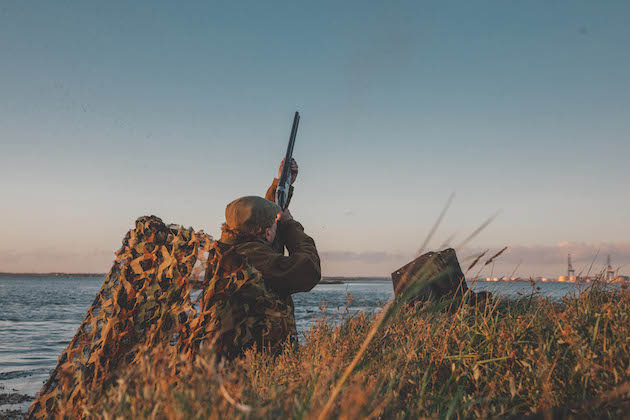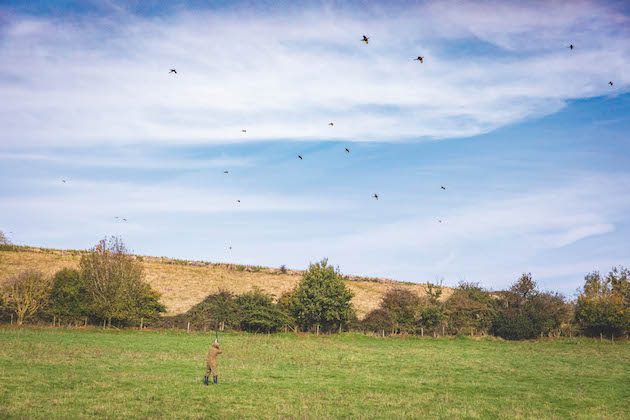The move from lead to steel is likely to force Guns to rethink their range, says Mike Swan
Could the ruling on lead mean the end of high birds? In the early 1990s, when we had a voluntary phase-out of lead for shooting over wetlands, my old mate Charles Nodder and I had a little try with some steel cartridges out on the Medway mud.
Being young and keen, we hit the road from Dorset at about 2am, with a view to being out on the Kent shore for morning flight. In those days, with wigeon and teal the main quarry, I usually used 28g lead 7s and my first 14 shots at dawn put five birds in the bag. From then on, I changed to steel, following the conventional advice to go up two sizes, and ended up shooting another 10 ducks, including a single pintail, for 32 burned.
If you do the sums, the cartridge to kills ratio goes from 2.8 to 3.2 to one, which is hardly significant. Add in that two of the 32 were used to finish off wounded birds on water during the tide flight and you could only conclude that there was no significant difference.

Mike Swan’s first experience of steel ammunition came on a wildfowling day on the River Medway
The end of high birds?
But what about the high ones? Now, I will confess right here that most of those birds were not long shots. Pulling at extreme range on the foreshore is a recipe for wounding and when the tide is in, ducks can easily escape the best of dogs by diving and disappearing. These were all shot at what I judged to be sensible ranges, but I did not hold back on what I considered to be fair chances. One rocketing wigeon killed with the second barrel was certainly memorable, so I think that part of the experiment was fair.
Lots of folk say that they can consistently kill high birds at 50 or perhaps 60 yards, but I question how they judge the distance. There is no opportunity to use a rangefinder, so actually they are mostly making an educated guess.
Whatever, it is true that steel is less dense than lead, so the frictional drag through the air will reduce pellet energy more quickly. Everything else being equal, a lead pellet of a given weight will fly a bit further and hit harder than its steel equivalent. But from a shotgun shooting point of view, everything is not equal. With lead being softer, it is more inclined to deform inside the barrel, potentially flying off at an angle, so steel patterns tend to be more consistent.

Many wildfowlers would not change back to lead from steel after three decades of use, even if they could
How far is too far?
So let’s ask another question. How far is too far? Well, for me and for the Code of Good Shooting Practice, anything beyond the reliable range of a shotgun is too far. Add in operator error and that should be re-stated as anything beyond your ability to kill consistently. And here is a real question to consider: at what distance do you become inconsistent?
Having shot for the pot all my life and dressed my own birds, I am convinced that instant collapse only happens when a pellet goes into the brain or breaks the neck. There is no magic cut-off where the pellets bounce off rather than penetrating.
As we get to the limit of reliable range, we run into a long zone where it is possible to drive pellets deep into, or even through, a bird’s body without bringing it down. As one well-known coach and author said, many who shoot high birds are really relying on the ‘golden pellet’ that happens to hit the spot. What he failed to add is that there can be several other birds badly wounded for each one that falls correctly struck.
In this regard, I remember going to a famous high bird shoot to help lead a GWCT shoot walk a few years ago. On the recce in advance, the host showed me two very high drives that he had abandoned, because even good teams shot too few birds. “It’s uneconomic to do them,” he said. “They may burn lots of cartridges, but they forget that when we come in short of the expected bag at the end of the day.” I might have added something about respect for quarry and moral acceptability.
Now, I am not for smashing low birds and I relish a testing one as much as anyone, but I do think that it will be no bad thing if the change away from lead persuades us to reassess what is sporting, even if it means the end of high birds.
I am very much of the view that shooting very high birds where there is a serious risk of wounding is unacceptable. Three decades of using either bismuth or steel for all my wildfowl shooting have convinced me that there is no problem with either. I am also reminded of some words from back then, penned by American shooter Worth Mathewson, who still writes for Shooting Times. He said he would not change back to lead even if he could, because he did not want to contemplate lead poisoning his quarry. I agree with him. My bigger concern with steel is that of slightly greater carcass damage if I let a bird get too close, not whether I can reach as far as with lead.

Guns should be looking for a consistent range
Suitable guns
Most who regularly shoot high birds have modern, long-chambered and steel-proofed guns to throw a heavier than ‘normal’ load, so the tool is already there. If it has tight chokes, they may need opening out a little, but steel usually patterns more closely than lead, so there should be little difference.
Clearly, we will all need to be careful not to use high-performance steel loads unless the gun is suitably proofed, but as the gun trade has said many times over the past couple of years, anyone who is worried about using standard steel in case of damage to their gun should ask whether it is safe even with lead.
Experimenting
The conventional wisdom with steel is that, because of its lower density, we should go up two shot sizes, but I am not entirely convinced that we need to go that far. We all need to do a bit of experimenting to find out what suits and then build our confidence.
For those whose normal shooting would be with a standard game load of lead 6s, I would suggest a shot at the pattern plate with a similar load of steel 5s. If this looks acceptable, the next step is to have a few sessions at clays, before moving to the real thing.
Lead is a real Achilles heel for shooting. We do great conservation, provide rural employment, deliver wonderful recreation for large numbers of people and generally enhance the countryside, but lead is a poison and our continued use gives detractors a stick with which to beat us.
This change is not the end of shooting as we know it. We might simply need to recognise slightly different limits, but we probably need to do that anyway.




